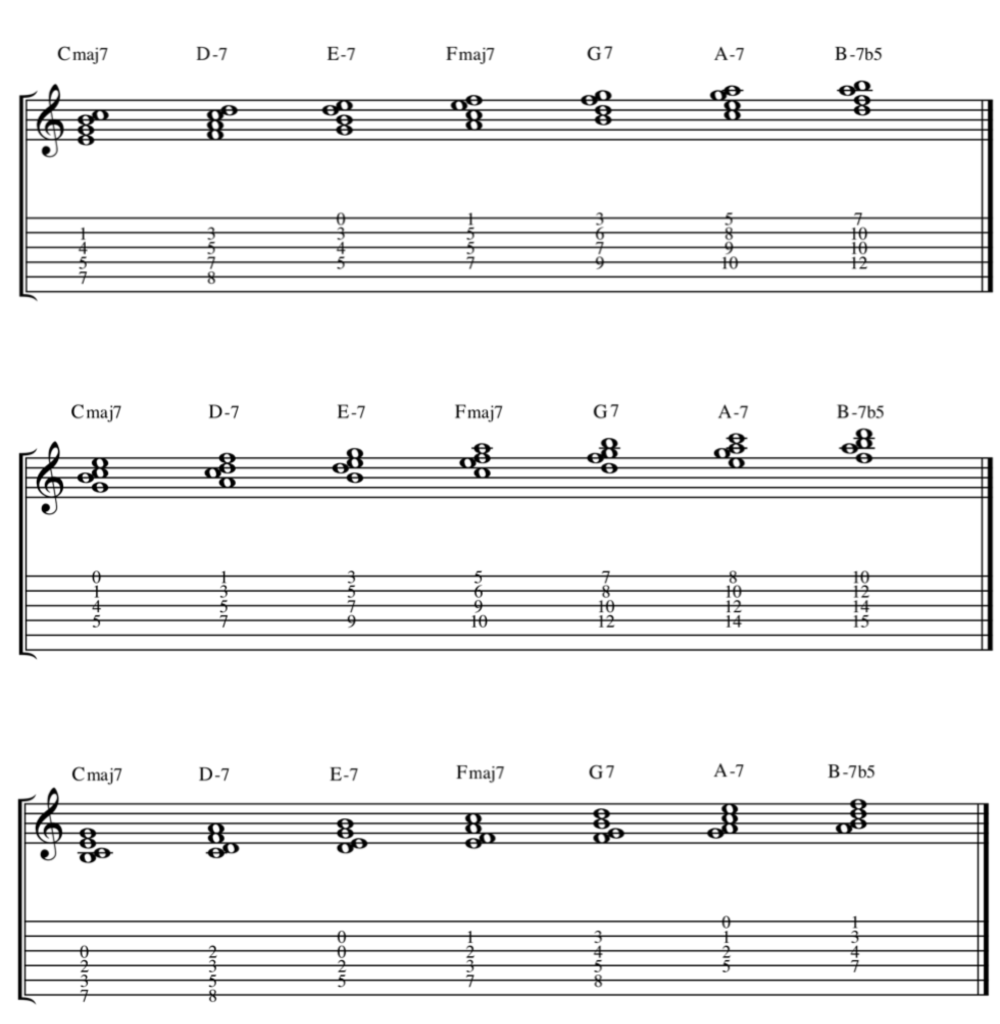Closed Voiced 7th Chords
When you stack another 3rd interval on top of the 5th of a triad, you get a 4-note chord: a 7th chord.
A 7th chord is called that because the distance from the root to the top note is a 7th interval when you stack 3 consecutive 3rd intervals.
As a quick recap: chords are built stacking 3rd intervals.
C to E = a 3rd
E to G = a 3rd
G to B = a 3rd
Putting these notes together, you get:
C E G B
C to B = a 7th (a 7-letter distance: C D E F G A B)
This is a Cmaj7 chord. The formula of the maj7 chord is 1 3 5 7
Here are the chord formulas for all 7th chords in the major scale.
There are 4 possible types of 7th chords in a major scale
maj7 = 1 3 5 7
(Dominant) 7 = 1 3 5b 7
-7 = 1 b3 5 b7
-7b5 = 1 b3 b5 b7
The following example shows all the root position 7th chords of a C major scale as closed voicings.

The words “major” and “minor” ALWAYS refer to the 3rd of the chord
The words “diminished” and “augmented” ALWAYS refer to the 5th.
The word “sus” (suspended) always refers to the 4th or 2nd
You know from the chapter on intervals, that there are 2 different 7th intervals: a major 7th and a minor 7th. I like calling the minor 7th INTERVAL a “b7” not to confuse students with a minor 7th CHORD.
The thing that is a bit confusing to students is the following:
When that 7th interval is added to the triad, now
The b7th interval used in a chord leads to the chord called “7” (G7, A7, Bb7, etc.)
And the major 7th interval is called “maj7”. In this case, the terminology “maj” does refer to the 7th interval.
The reason btw why you would not label the 7ths in the chord the same way you name them as an interval is that the label b7 would be confusing in a chord name.
For example: if you would label a b7 interval as “b7” in a chord name, then in a chord like Gb7 you would have no way of knowing whether the “b” refers to the G or to 7th.
It would be unclear whether it means: Gb with a 7th, or G… with a b7th.
It is for that reason that the b7th interval is labeled in the chords as “7” with the flat omitted and the major 7th interval is labeled as “maj7”.
Inversions of Closed Voiced 7th Chords
Many of these voicings are not practical on a guitar.
I have added the tablature so you can see what I mean.
These voicing all work really well on piano, but because of the build, tuning, and organization of the notes on a guitar, the notes are physically too widely spread out over the guitar neck for many of these voicings to be practical.
Still, some of these closed 7th chord voicings work well and you want to memorize those chord voicing so you can use them in your playing.
There is of course also always the consideration of playing them up an octave (up 12frets), where the frets are much more closely spaced.

Conclusion
Hit me up anytime at vreny@zotzinmusic.com if you have any questions, or if you would like to book a lesson.
These free lessons are cool, but you will never experience the progress, joy, and results that my students experience in lessons when you’re learning by yourself from blogs and videos.
That is why people take lessons: way better results and progress, much more complete information, exposed to way more creative ideas than you can get from a blog or YouTube video.
There is only so much that self-study can accomplish.
If you want to see amazing results and progress in your guitar playing, buy your first lesson here and get started ASAP.
You’ll impress your friends and loved ones in no time with your guitar playing!
Consider donating any small amount to help me keep this blog going.
Thank you for your support!


